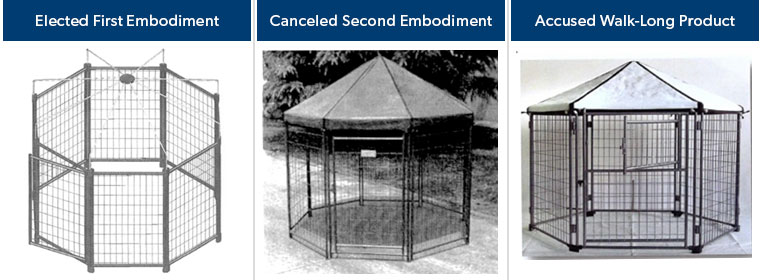
Restriction Requirements and Prosecution History Estoppel in Design Patents
Design patent practitioners gave a cautious sigh of relief recently when the Federal Circuit held that Advantek is not estopped by the prosecution history from asserting U.S. Patent No. D715,006 (the ‘006 patent) against Walk-Long and its Pet Companion kennel. Advantek Marketing, Inc. v. Shanghai Walk-Long Tools Co., Ltd., 2017-1314, (Fed. Cir. August 1, 2018)
In 2016, Advantek asserted its design patent directed to a pet kennel against a similar kennel sold by Shanghai Walk-Long Tools Co. (Walk-Long). During prosecution of the ‘006 patent, the U.S. Patent and Trademark Office issued a restriction requirement between a first embodiment shown in Figures 1-4 and drawn to a kennel without a cover and a second embodiment shown in Figures 1-5 and drawn to a kennel with a cover, as shown below. The embodiments were substantially the same except for the cover shown in Figure 5. In response to this restriction requirement, Advantek elected the first embodiment shown in Figures 1-4, and Figure 5 was withdrawn and ultimately canceled from the application. Hence, when the ‘006 patent was asserted against the Walk-Long product, shown below, Walk-Long argued that Advantek had intentionally surrendered patent claim scope that would have included gazebos with a cover in response to the restriction requirement, thereby limiting the scope of the ‘006 Patent to gazebos without a cover. The district court granted the motion and dismissed the complaint, stating that Advantek had "surrender[ed] the proposed kennel with a cover...to secure a patent" by "choosing one of two drawings in response to a restriction requirement."

Relying on Pacific Coast Marine Windshields Ltd. v. Malibu Boats, LLC, 739 F.3d 694 (Fed. Cir. 2014) in granting dismissal on the pleadings, the District Court noted that Advantek had (1) surrendered the unelected embodiment (i.e., a kennel with a roof cover), (2) that this surrender was for reasons of patentability (i.e., to overcome a restriction requirement), and (3) that the accused Walk-Long design (shown above) was within the scope of the surrendered design.
On appeal, Advantek focused on the third prong of the Pacific Coast test and argued that Walk-Long's accused design falls outside any claim scope Advantek purportedly surrendered during prosecution. Advantek argued that its elected design is the "skeletal structure design," and that this design is present in the accused kennel, with or without a cover. Advantek stated that the accused kennel as shipped, assembled, and used, does not have a cover unless or until a cover is placed on the kennel.
The Federal Circuit concluded that Advantek elected to patent the ornamental design for a kennel with a particular skeletal structure and that a competitor who sells a kennel embodying Advantek's patented structural design infringes the '006 patent, regardless of extra features, such as a cover, that the competitor might add to its kennel.
While this case has been remanded, Pacific Coast still dictates that design applicants use caution when filing multiple design embodiments within a single U.S. application, recognizing that any embodiment withdrawn from an application, and not pursued in a related application, may be available to competitors.


